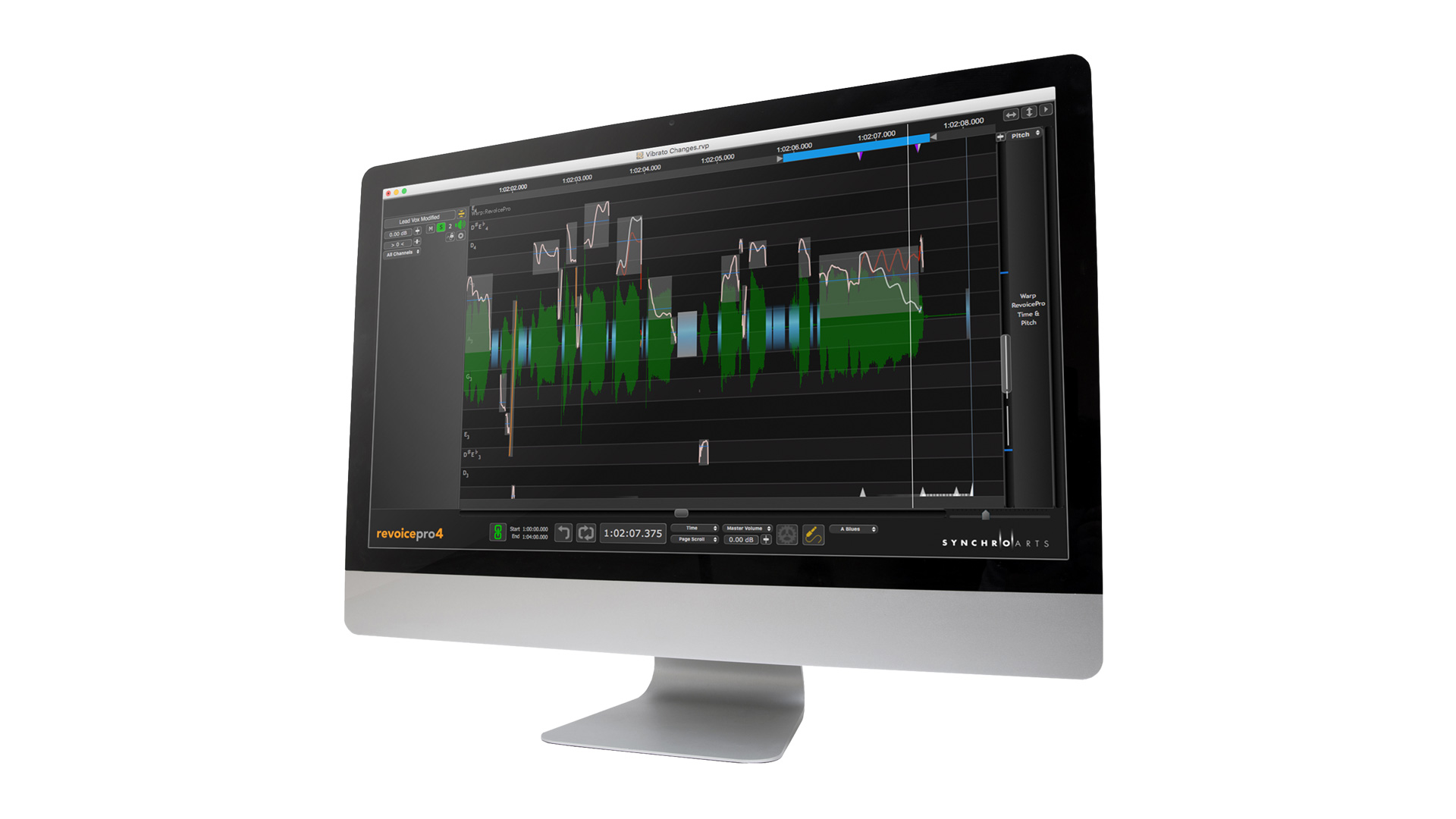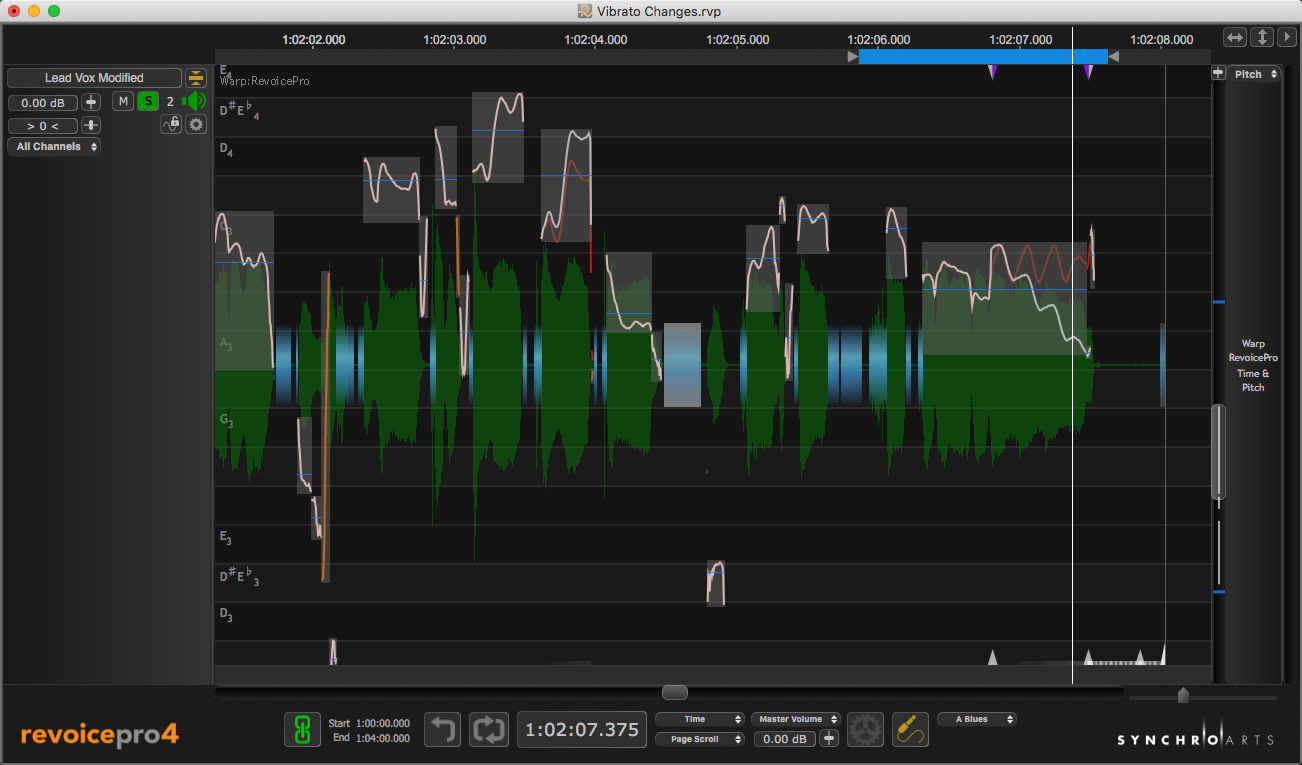Revoice Pro 4 is Synchro Arts’ latest version of an app that not only can be used for ADR and synchronization but also for creating double tracks from one input signal, providing creative time- and pitch-modulation effects, and manually and automatically changing the time and pitch of voice and monophonic instrument recordings.
The app comes with Audio Suite, AAX, AU, and VST3/ARA2 plug-ins to integrate efficiently with DAWs including Pro Tools, Logic Pro X, Studio One, Cubase, and several others. Although Revoice Pro can process the audio from FCPX, because Final Cut Pro X does not provide timecode to Revoice Pro, it is impossible to spot the “aligned” audio automatically to the right timecode in FCPX, so it must be positioned manually.
In essence, Revoice Pro is a standalone application; the DAW plug-ins are a system to exchange audio signals, both before and after processing. Those working in a video or movie environment might be wondering about the difference between Revoice Pro and PluralEyes. Revoice Pro performs alignment completely differently than PluralEyes. PluralEyes delivers specific and rather simple waveform alignment functionality, whereas Revoice Pro aligns signals based on energy profiles. That opens up all kinds of possibilities in terms of efficiency and creativity. For example, it lets you control what a synchronised signal will sound like exactly.

Revoice Pro’s Audio Performance Transfer process clones timing, pitch, vibrato and level from one audio track to another.
Synchro Arts
For filmmakers and video creators, Revoice Pro is a dream app to sync alternative takes, wild tracks and ADR to the production dialogue. In addition, it will allow you to transfer intonation patterns from one take to another. It will even do that with a director’s audio input or let you start from scratch and create the weirdest intonation patterns you’d like.
In most cases, Revoice Pro will also reduce the time you spend on manual editing of timing, pitch, vibrato or loudness of audio signals.
Examples of jobs for Revoice Pro in both video and audio environments include the creation of “tight” double (or multiple) tracks from multiple takes, the modification of the inflection of spoken phrases from one actor’s take to match another take of the same or a different actor, the creation of one or more realistic double tracks from a single input track, and tightening the time and pitch of stacked lead and harmony parts.
Revoice Pro has been designed for use as a standalone application, with the plug-ins sending audio signals to Revoice Pro for further processing. I tried it with the Logic Pro X plug-in.
Because Revoice Pro itself is a true application and not a plug-in, you are working in a dedicated app. That brings with it significant advantages, such as the fact that, whatever your source app’s location may be, you don’t have to concentrate on doing things differently depending on the host’s interface. It also allows you to implement multi-input processes and use a “region-based processing” approach in which inputs to processing modules are inserted where required along the timeline in Process Control Tracks. One of its most useful features is that it enables you to protect parts of the audio signal from processing in Protected Areas — more on that below.
Experiences
I first tried using Revoice Pro to synchronize signals between audio recorded with a video camera and an audio recorder. For that to work, I decided it was best to export the audio from the Final Cut Pro X timeline, feed it to Revoice Pro by dragging the resulting file to the Desktop and adding the audio recorder file. Then, when the synchronization was finished, I could just drag it back into Final Cut Pro X and line it up with the original before silencing the latter.
As I had some extra time at the start of the audio recording that I didn’t have in the camera recording, I cut off the start of the separate audio track to match the in-camera recording in Revoice Pro, so I could just line up at the start of the timeline.
This is a very simple example of how you could use Revoice Pro, but it can solve many other, more disturbing problems. For example, I tested the same sort of synchronization with an audio recorder file where the signal not only differed at the start but also drifted out of sync farther down the recording.
This is a problem that would be impossible to correct with an app that only synchronizes waveforms but, because Revoice Pro syncs signals based on energy, a quick read of the user guide and a few tweaks did the job.
This will even work when you feed Revoice Pro an audio signal that drifts a full five seconds compared to the original. When I tried that, Revoice Pro synchronized the two at the start of the recording, let me set the timing of the result to a different alignment mode, and recalculated the outcome so that I ended up with two perfectly aligned clips at both start and end, and with a voiceover that sounded like slow-motion but remained at the same pitch as the original.
And that’s not all Revoice Pro enables you to do. For example, you can start and stop edits wherever you want along the audio track using Protected Areas, one of the most important features of the app. Protected Areas allow you to protect pitch, timing or both in specific areas of the signal. For example, if the intonation in a voice-over or song is best left alone in some areas, Revoice Pro lets you protect these and change only where it’s needed.
Revoice Pro lets you process parts of audio signals differently from others as well. For example, by selecting only part of a track and adding a new process to the same output track, you can create Process Control Blocks. They’re called “Blocks” because they actually create a different effect per block of audio anywhere you want on the track.
For example, when you have a recording that is too quiet in only some areas of your recording, you can create a Process Control Block that lets you turn up the volume in only those areas.
Of course, this sort of flexibility and processing power lets you not only fix audio or put it in sync with a master recording, but also create wildly creative sound effects that can sound otherworldly — and which aren’t limited to vocal tracks, either.
Conclusion
If you’re only after a synchronization app for your movie or video, Synchro Arts has a dedicated offering besides called VocAlign, but if you have the budget my advice would be to go with Revoice Pro for multiple reasons:
- For voiceovers to closely sound like the original and run in sync with it
- To sync recordings simply and accurately, based on the signal’s energy
- To sync audio that drifts over time
- For creative effects with vocals and music
Revoice Pro is used by professionals all over the world, both in sound engineering and video. The MSRP is $599; at this writing, it’s available for a 20% discount from Synchro Arts.











